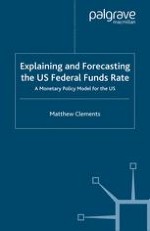2004 | Buch
Explaining and Forecasting the US Federal Funds Rate
A Monetary Policy Model for the US
verfasst von: Matthew Clements
Verlag: Palgrave Macmillan UK
Buchreihe : Palgrave Macmillan Finance and Capital Markets Series
Enthalten in: Professional Book Archive
